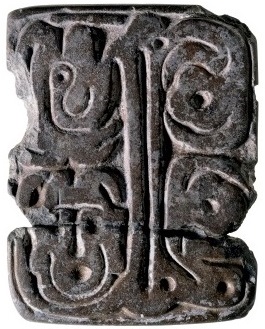© 2014 B. L. Freeborn, updated Sept. 2022
The Waverly Tablet was created by an artist with a very skilled hand. The image is clear, sharp and symmetrical. It is located in the Cincinnati Art Museum.
The tablet displays the four panel style with the center bar which by now we understand immediately. In fact there is little about this tablet that the reader cannot discern for themselves. In the upper left Baal, the comet, appears in its two tailed form. The man seems to exclaim ‘oh’ or ‘no!’ upon seeing it. In this image his mouth forms the round empty crater. His face spells out wa-ur (where) just as in the Low Tablet. The pole is represented with a rounding at the top and bottom. The bottom gives a very definite negative shape like water waves or mountain peaks. I suggest it is the latter since the story relates to a prior era when great ice mountains laid over Ohio so heavily it was 800 feet lower in elevation and completely uninhabitable. It is also suggested by the name of the goddess Isis which was studied in Berlin Tablet post. There it was suggested Isis means ‘ice-sess’ or ‘ice-seat.’
On the right side there is disarray as two people ornately designed to double as flowers lie dead, shot through the head as if to say all was destroyed. The short bar at the top provides a sound. It appears to be symbol #383 or ‘ra’. The center bar is a form of ‘I’ and combining them we have the word ‘i-ra’ which remains unchanged through the centuries. It is ire or anger which is appropriate to the scene. Anger was clearly portrayed in the spider-like Gaitskill Tablet. ‘Ire’ also means to wander. So, it doubly suggests movement of the pole.
Numbers are supplied by punch marks and the four panel layout. We find 1, 4 provided by the layout and 4 x 14 = 56. In the top left panel there is 1 punch. The face panel provides 3, the upper right provides 2, and lower right provides 3 for a total of 9. This provides the 9 in 792. The two dots on the bar provide the 2. The remaining 7 are in the images. Hence, 792 is found.
On the left side between the upper-lower panels is a punch provided in the negative which allows 23 32 to be found on both halves. The short bar at the top provides 1, the bar 1 and the two dots complete 1,1,2. Each flower person provides 1,1,2 by using the dot, the head and then the two arms surrounding each head. If the bulb of the nose is counted as 1 then the left side provides 6 and the right side 5 for 56. The upper most center dot gives 1, the lower dot 1 and the sides of the bar gives 2 for 1,1,2 again or 2 x 56.
On the right side if the dots are counted left to right from top to bottom a group of 3 is found followed by 2. Reading from bottom to top there are 3 lines of 3 for 333. This number we have seen many times on the tablets. There are 9 distinct dots. If the nose and negative dot are added to the sum there are 11 or write this as 92. The latter suggests the distance Earth lies from the Sun. Or if you prefer 29 and this is half of 58. The distance Earth travels in a year is 584 million miles.
The Baal panel, upper left, seems to provide a line on the left which might have formed a dish or crater. This would have then given 1,1,2 as 1 crater, 1 eye, 2 tails.
The tablet measures 3 3/8 x 2 5/8 x 13/16 inches. The sum of the sides is 6 inches. The area of the face is then 8.86 sq. in. and a volume of 7.2 cubic inches. The product of 6 and 88 is 528. There are 5280 feet in a mile. The tenth mile appears at earthwork sites such as Newark. The diagonal calculates to 4.3 inches and twice this is 8.6.
These are all numbers we have seen before but their importance is contingent on the inch being in use by the artist. The ratio of the side lengths however eliminates units. The ratio is .777 which is significant.
Since this tablet portrays so many numbers it might be time to recall the number list and update it. The updated list includes: 108, 111, 112, 1212, 14, 16, 17, 212, 21212, 2166, 222, 23, 23 32, 23.5, 24, 241, 2486, 26, 31, 32, 33, 333, 34, 40, 43, 52, 54, 56, 56.5, 56.564, 58, 6, 66, 66624, 7, 72, 76, 777, 79, 792, 86, 88, 9, 90, 92, 93.3, 7924 and 8642. Now that they are getting easy to read let us try something a wee bit more complex.
Next post on Gaitskill Clay Tablet
———————-
See David Penny’s Article on these stones here.
————————
Back to very first post on Adena Tablets
Previous Post on The Low Tablet
Posts on: Allen Tablet, Grave Creek, The Kiefer Tablet,
Wright, Lakin B and Meigs Tablets, Berlin Tablet,
Gaitskill Stone Tablet , Metcalf Stone, and pdf article on
Hudson Bay as a comet crater of recent origin.
